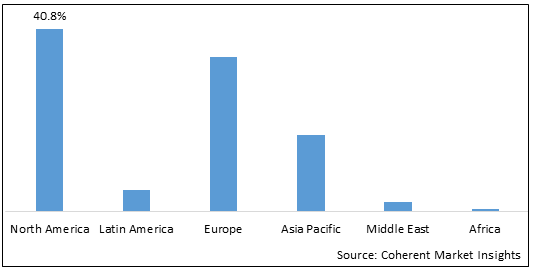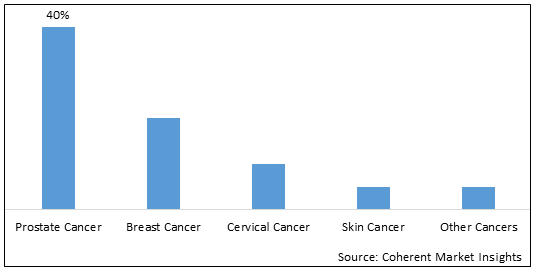Hyperthermia Cancer Treatment Market is estimated to be valued at USD 210.5 Mn in 2025 and is expected to reach USD 318.6 Mn in 2032, exhibiting a compound annual growth rate (CAGR) of 6.1% from 2025 to 2032. Hyperthermia cancer treatment involves raising the temperature of a tumor to damage and kill cancer cells. It is used along with other cancer treatments like chemotherapy and radiation therapy. The major advantage of hyperthermia treatment is that it increases blood flow and oxygen to the tumor area, making chemotherapy and radiation more effective.
The hyperthermia cancer treatment market is segmented by treatment type, application, end user, and region. By treatment type, the market is segmented into local hyperthermia, regional hyperthermia, and whole body hyperthermia. Local hyperthermia is expected to account for the largest market share during the forecast period. This is attributed to its ability to heat small and deep tumors in a focused manner.
Hyperthermia Cancer Treatment Market Regional Insights
- North America is expected to be the largest market for hyperthermia cancer treatment market during the forecast period, which is estimated to account for 40.8% of the market share in 2025. The growth of the market in North America is attributed to the high adoption of advanced hyperthermia devices, increasing prevalence of cancer, and growing awareness about hyperthermia therapy.
- The Europe market is expected to be the second-largest market for hyperthermia cancer treatment market, which is estimated to account for 34.6% of the market share in 2025. The growth of the market in Europe is attributed to the rising healthcare expenditure, presence of leading device manufacturers, and increasing clinical trials to study hyperthermia.
- The Asia Pacific market is expected to be the fastest-growing market for hyperthermia cancer treatment market, with a projected CAGR of 9.3% during the forecast period. The growth of the market in Asia Pacific region is attributed to the large target patient population, improving healthcare infrastructure, and the focus of key players in emerging APAC countries.
Figure 1. Global Hyperthermia Cancer Treatment Market Share (%), by Region, 2025

To learn more about this report, Download Free Sample
Analysts’ Views on Hyperthermia Cancer Treatment Market:
The hyperthermia cancer treatment market is driven by the demand for improved cancer treatments and the potential of hyperthermia to enhance the effectiveness of radiation and chemotherapy. Technological advancements and clinical evidence supporting its efficacy in certain cancer types further drive market growth.
However, market growth is anchored by certain factors, which include challenges in standardization, side effects, and the requirement for specialized equipment and expertise. Regulatory complexities and the need for further clinical validation in larger patient populations also impede market expansion.
Addressing market restraints requires standardized treatment protocols, minimizing side effects, and conducting extensive clinical trials to establish efficacy across various cancer types. Overcoming regulatory challenges and increasing awareness among healthcare providers will be pivotal. Future trends may see increased collaboration between hyperthermia and emerging therapies, expanding its application and improving patient outcomes. The market's success will hinge on advancing technology, demonstrating safety and efficacy, and integrating hyperthermia within the broader spectrum of cancer treatment options.
Hyperthermia Cancer Treatment Market Drivers:
- Increasing prevalence of cancer worldwide: The rising prevalence of various types of cancer, such as breast cancer, prostate cancer, cervical cancer, and skin cancer is a major factor driving the hyperthermia cancer treatment market. The increasing patient pool is creating significant demand for advanced and effective cancer treatment methods like hyperthermia therapy. Hyperthermia is increasingly being used along with chemotherapy and radiation therapy to improve outcomes. The growing disease burden is therefore fueling the adoption of hyperthermia devices.
- Rising awareness about hyperthermia therapy: There is increasing awareness among oncologists and patients about the ability of hyperthermia therapy to enhance the effects of chemotherapy and radiation therapy. Extensive research validating the benefits of hyperthermia and its ability to improve tumor oxygenation is driving its acceptance in clinical settings. Conferences, symposiums, and workshops aimed at increasing awareness are propelling the growth of hyperthermia cancer treatment market. Social media campaigns by manufacturers, cancer foundations, and healthcare providers are also boosting awareness.
- Strong product pipeline and new product launches: Key players in the hyperthermia cancer treatment market are continuously launching innovative devices to strengthen their product portfolios. Andromedic's Adrovance Multifield Generator enables both capacitive and radiative superficial hyperthermia. The launch of advanced microwave, ultrasound, infrared hyperthermia devices is expected to further propel market growth during the forecast period.
- Technological advancements in hyperthermia devices: The integration of technologies such as MRI thermometry, advanced heat delivery techniques, and real-time temperature monitoring in hyperthermia devices is enhancing selective tumor heating while protecting surrounding healthy tissues. The emergence of improved capacitive and radiative heating to achieve higher tumor temperatures is also a key driver. Further, the development of minimally invasive techniques like interstitial and intracavitary hyperthermia is expanding clinical applications.
Hyperthermia Cancer Treatment Market Report Coverage
| Report Coverage | Details | ||
|---|---|---|---|
| Base Year: | 2024 | Market Size in 2025: | USD 210.5 Mn |
| Historical Data for: | 2020 To 2024 | Forecast Period: | 2025 To 2032 |
| Forecast Period 2025 to 2032 CAGR: | 6.1% | 2032 Value Projection: | USD 318.6 Mn |
| Geographies covered: |
|
||
| Segments covered: |
|
||
| Companies covered: |
MagForce AG, Andromedic S.r.l., Celsius42 GmbH, Oncotherm Kft, Pyrexar Medical, YAMAMOTO VINITA CO.,LTD, Nanoprobes, Alba Hyperthermia System, Novavida, and Sensius |
||
| Growth Drivers: |
|
||
| Restraints & Challenges: |
|
||
Uncover macros and micros vetted on 75+ parameters: Get instant access to report
Hyperthermia Cancer Treatment Market Opportunities:
- Growing popularity of nanoparticle-mediated hyperthermia: The use of magnetic nanoparticles and gold nanorods for localized tumor hyperthermia is rising rapidly. Nanoparticles act as precise localized heat sources due to their ability to absorb particular wavelengths. Extensive Research & Development focused on improving the biocompatibility, tumor targeting efficiency, and heating abilities of nanoparticles is underway. The significant potential of this non-invasive, targeted approach provides lucrative growth opportunities.
- Combination therapy with existing cancer treatments: The synergistic effects of hyperthermia therapy with chemotherapy, radiotherapy, and immunotherapy are being increasingly studied through preclinical and clinical trials. Combination with existing cancer treatments is proving effective in reducing tumor size and improving patient survival. The expanding clinical evidence regarding enhanced outcomes will present attractive opportunities for market growth.
- Emerging applications in immunotherapy: Research focused on exploiting the immunomodulatory effects of hyperthermia is rising. Hyperthermia is being studied as an immunotherapy enhancer using approaches like hyperthermia-triggered oncolytic virus delivery, hyperthermia-induced heat shock protein production, and improving dendritic cell activation. The potential of hyperthermia to stimulate anti-tumor immune responses will open up growth avenues.
- Growing demand in developing regions: The hyperthermia cancer treatment market has significant expansion opportunities in developing regions like China, India, Brazil, and Southeast Asia. The increasing prevalence of cancer, improving healthcare infrastructure, rising disposable incomes, and increasing healthcare spending in these regions are expected to drive the adoption of hyperthermia therapy. Local players are also launching affordable products to tap the large, underserved patient pool.
Hyperthermia Cancer Treatment Market Trends:
- Integration with advanced imaging techniques: The integration of hyperthermia systems with advanced 3D imaging techniques like CT, MRI, and PET scans is rising. Imaging allows accurate tumor localization, treatment planning, and real-time temperature monitoring to ensure safe thermal dose delivery. Imaging coupled with hyperthermia improves targeting and reduces side effects, driving its adoption. Vendors are increasingly integrating imaging capabilities in their systems.
- Development of deep hyperthermia devices: New hyperthermia devices are being developed to safely induce therapeutic heating in deep-seated tumors. Techniques like 3D-focused ultrasound, phased-array microwave systems, and advanced RF applicators are being adopted for deep heating. For instance, the Sonotherm 1000 focused ultrasound device by Labthermics Technologies, Inc., a medical therapy products company dedicated to improving cancer treatment, enables conformal heating of deep tumors. The trend toward non-invasive deep hyperthermia is expected to continue.
- Emergence of MRI-guided hyperthermia systems: MRI-guided hyperthermia therapy is an emerging trend enabling accurate thermometry and temperature control during treatments. MRI provides real-time thermal maps of the tumor and surrounding normal tissue. Companies like Pyrexar Medical offer the BSD-2000 MRI-guided hyperthermia system, which provides optimized electromagnetic energy delivery. The rising availability of MRI-compatible systems will support market growth.
- Growing number of clinical trials: Many clinical studies are underway to evaluate the safety, efficacy, and optimal protocols of hyperthermia therapy for different cancer types and stages. Trials are also focused on studying combination therapies, establishing thermal dose thresholds, and quantifying therapeutic synergy. The increasing clinical evidence from trials regarding improved patient outcomes is expected to increase acceptance among clinicians and patients.
Hyperthermia Cancer Treatment Market Restraints:
- High costs of hyperthermia systems: Hyperthermia systems involve high upfront costs ranging from US$ 150,000 to US$ 500,000. Additional costs are incurred for annual maintenance contracts. The low awareness and lack of reimbursement for hyperthermia therapy in several countries have restrained adoption by small clinics and hospitals with budget constraints. This acts as a key challenge, especially in developing regions.
- Skin burns and discomfort: The adverse effects of hyperthermia, like skin burns, substantial pain, and discomfort have limited its adoption for cancer treatment. Technological constraints preventing uniform heating of tumor tissues also increase side effects. High temperatures can damage surrounding healthy tissues and increase toxicity when used along with other modalities. These factors have hindered market growth.
- Shortage of trained personnel: The procedure requires trained oncologists, technicians, physicists, and nurses skilled in operating and maintaining the hyperthermia devices. However, many regions face a significant shortage of personnel trained in hyperthermia therapy protocols and procedures. The lack of expertise in performing safe and effective hyperthermia procedures has negatively impacted adoption.
Counterbalance: Key players in the market should focus on training healthcare personnel and raising awareness about the hyperthermia cancer treatment. Focus on training the healthcare personnel can help improve the efficiency of the process significantly.
Figure 2. Global Hyperthermia Cancer Treatment Market Share (%), by Application, 2025

To learn more about this report, Download Free Sample
Top companies in Hyperthermia Cancer Treatment Market
- MagForce AG
- Andromedic S.r.l.
- Celsius42 GmbH
- Oncotherm Kft
- Pyrexar Medical
- YAMAMOTO VINITA CO.,LTD
- Nanoprobes
- Alba Hyperthermia System
- Novavida
- Sensius
Definition: Hyperthermia cancer treatment involves raising the tumor temperature between 40-45°C using energy sources like microwaves, radiofrequency, and ultrasound. It makes cancer cells more susceptible to damage by inhibiting DNA repair and increasing blood flow and oxygenation. Hyperthermia enhances the effects of radiotherapy and chemotherapy without excessive damage to normal tissue. It can be used alone or along with other cancer treatments. Hyperthermia devices include microwave, ultrasound, infrared, and capacitive heating devices used to apply heat to tumors and damage cancer cells.
Share
Share
About Author
Abhijeet Kale is a results-driven management consultant with five years of specialized experience in the biotech and clinical diagnostics sectors. With a strong background in scientific research and business strategy, Abhijeet helps organizations identify potential revenue pockets, and in turn helping clients with market entry strategies. He assists clients in developing robust strategies for navigating FDA and EMA requirements.
Missing comfort of reading report in your local language? Find your preferred language :
Transform your Strategy with Exclusive Trending Reports :
Frequently Asked Questions
Select a License Type
EXISTING CLIENTELE
Joining thousands of companies around the world committed to making the Excellent Business Solutions.
View All Our Clients




